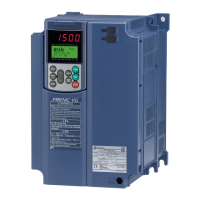Chapter 6: Function codes and application example
E codes: Extension terminal functions
Code Name Data setting range Default setting
E01 0
E02 1
E03
Selecting function code data assigns the corresponding function to terminals [X1] to [X5] as
listed below.
2
E04 7
E05
8
Terminal [X1]Function
Terminal [X2] Function
Terminal [X3] Function
Terminal [X4] Function
Terminal [X5] Function
0 (1000): Select multistep frequency
1 (1001): Select multistep frequency
2 (1002): Select multistep frequency
3 (1003): Select multistep frequency
4 (1004): Select ACC/DEC time
6 (1006): Enable 3-wire operation
7 (1007): Coast to stop
8 (1008): Reset alarm
9 (1009): Enable external alarm trip
10 (1010): Ready for jogging
11 (1011): Switch frequency command 2/1
12 (1012): Select Motor2 / Motor1
13 : Enable DC braking
14 (1014): Select Torque Limiter Level
17 (1017): UP (Increase output frequency)
18 (1018): DOWN (Decrease output frequency)
19 (1019): Enable write from keypad (Data changeable)
20 (1020): Cancel PID control
21 (1021): Switch normal/inverse operation
24 (1024): Enable communications link via RS485 or field bus
(option)
25 (1025): Universal DI
26 (1026): Enable auto-search at starting
27 (1027): Speed feedback control switch
30 (1030): Force to stop
33 (1033): Reset PID integral and differential components
34 (1034): Hold PID integral component
42 (1042): Position Control limit switch
43 (1043): Position Control start/reset command
44 (1044): Switch to the serial pulse receiving mode
45 (1045): Enter position control return mode
46 (1046): Overload stopping effective command
Setting the value of 1000s in parentheses () shown above assigns a
negative logic input to a terminal.
Note: In the case of THR a Stop, data (1009) and (1030) are for
normal logic, and “9” and “30” are for negative logic, respectively.
[SS1]
[SS2]
[SS4]
[SS8]
[RT2/RT1]
[HLD]
[BX]
[RST]
[THR]
[JOG]
[Hz2/Hz1]
[M2/M1]
[DCBRK]
[TL2/TL1]
[UP]
[DOWN]
[WE-KP]
[Hz/PID]
[IVS]
[LE]
[U-DI]
[STM]
[PG/HZ]
[STOP]
[PID-RST]
[PID-HLD]
[LS]
[S/R]
[SPRM]
[RTN]
[OLS]
E10 Acceleration Time 2
0.00 to 3600 s
Note: Entering 0.0 cancels the acceleration time, requiring external soft start
10.0
E11 Deceleration Time 2 0.00 to 3600 s
Note: Entering 0.00 cancels the deceleration time, requiring external softstart.
10.0
E16
20 to 200 %
999 : Disable
999
E17
Torque Limiter 2
(Limiting level for driving)
(Limiting level for braking)
20 to 200 %
999 : Disable
999
E20 Terminal Y1 function 0
E21 Terminal Y2 function
7
E27 Terminal 30A/B/C function (Relay
output)
99
Selecting function code data assigns the corresponding function to
terminals [Y1] to [Y2] and [30A/B/C] as listed below.
0 (1000): Inverter running
1 (1001): Frequency arrival signal
2 (1002): Frequency detected
3 (1003): Undervoltage detected (inverter stopped)
4 (1004): Torque polarity detected
5 (1005): Inverter output limiting
6 (1006): Auto-restarting after momentary power failure
7 (1007): Motor overload early warning
10 (1010): Inverter ready to run
21 (1021): Frequency arrival signal 2
22 (1022): Inverter output limiting with delay
26 (1026): Auto-resetting
27 (1027): Universal Digital Output
28 (1028): Heat sink overheat early warning
30 (1030): Service life alarm
33 (1033): Command loss detected
35 (1035): Inverter output on
36 (1036): Overload prevention control
37 (1037): Current detected
38 (1038): Current detected 2
42 (1042): PID alarm
49 (1049): Switched to motor 2
57 (1057): Brake signal
76 (1076): PG error signal
80 (1080): Stop position override (Over Travelling)
81 (1081): Indication of total elapsed time for one positioning cycle
82 (1082): Completion of positioning
83 (1083): Current position pulse overflow
99 (1099): Alarm output (for any alarm)
Setting the value of 1000s in parentheses () shown below assigns a
negative logic input to a terminal.
[RUN]
[FAR]
[FDT]
[LU]
[B/D]
[IOL]
[IPF]
[OL]
[RDY]
[FAR2]
[IOL2]
[TRY]
[U-DO]
[OH]
[LIFE]
[REF OFF]
[RUN2]
[OLP]
[ID]
[ID2]
[PID-ALM]
[SWM2]
[BRKS]
[PG-ERR]
[OT]
[TO]
[PSET]
[POF]
[ALM]

